Bulbous and tuberous indoor flowers

Indoor plants are the most successful decorations for any interiors and adjoining areas. With such decorations, the home becomes more comfortable and attractive. There are many different types of indoor flowers. Among them there are both capricious and demanding and unpretentious specimens that are grown easily even by inexperienced growers.
In today's article, we will take a closer look at the different varieties of bulbous and tuberous pets and learn how to properly care for them.



Peculiarities
Bulbous and tuberous houseplants can be great additions to any interior design. Such details do not make the atmosphere oversaturated or annoying; on the contrary, with flowers the interior composition becomes more aesthetic and pleasant. But it is not enough just to choose the representative of the green world you like. You still need to properly care for it and take into account all its features. If you do not care about the flowers of the type in question, they are unlikely to delight household members with their beauty for a long time.
Bulbs and tubers are underground storehouses, due to which the plant calmly survives various bad weather, low temperatures or dry periods. These are original organs saturated with all the necessary nutrients. Thanks to them, the plant can quickly form new shoots after the obligatory dormant period. Very beautiful flowering ornamental plants can be grown from the tubers.
After flowering, such green pets die off, leaving behind live baby tubers that can germinate in comfortable conditions for them.
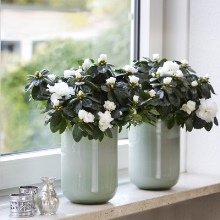


Bulbous representatives of their own species can be attributed to a separate category. In their arsenal, these individuals have a bulb, which acts as a separate bud. In addition, this part is needed in order to store moisture. The main distinguishing feature of these flowers from other existing plants is the presence of a certain amount of leaves, initially located in the inner part of the bulb. On one side of the latter, there is a small bottom, where there is an initial root system.
Both bulbous and tuberous flowers can look spectacular and elegant if you provide them with the most comfortable conditions for growth. When developing a scheme for caring for flowers of these types, it is necessary to take into account the characteristics of the species to which they belong, and there are a lot of them.



Species overview
Indoor tuberous and bulbous flowers are represented by a huge number of different species, each of which has its own distinctive features and external characteristics. Let's take a closer look at the most popular and common types of considered domestic plants.
Spiral albuka
It is a bulbous herb. Its country of origin is South Africa. Albuca is subdivided into many different subspecies, which give off a pleasant aroma reminiscent of vanilla. When this beautiful crop fades, small fruits in the form of seed bolls are formed on it.
The bulb of this plant has a round structure and is slightly flattened. Differs in white or light yellow color. The leaf plates of this plant usually reach 15 cm and are collected in a voluminous root rosette. Each flower has its own pedicel, the height of which is at least 4 cm. Albuka is a big lover of light.
In order for this flower to grow actively at home, it should be placed on a windowsill, "looking" to the south.


Rodophiala
A bulbous plant that is not so common in the collections of gardeners. The homeland of this flower is Argentina and Chile. There are about 40 species of Rodophial, and only 6 of them can be grown at home.
The bulb of this plant can remain in a state of suspended animation for a long period. An arrow with large flowers appears only towards the end of the summer season. When the flowering stage is completed, several leaves grow, which have a characteristic belt-like shape. This flower needs enough light.
It is important for the healthy growth of the flower to provide the plant with only moderate watering.
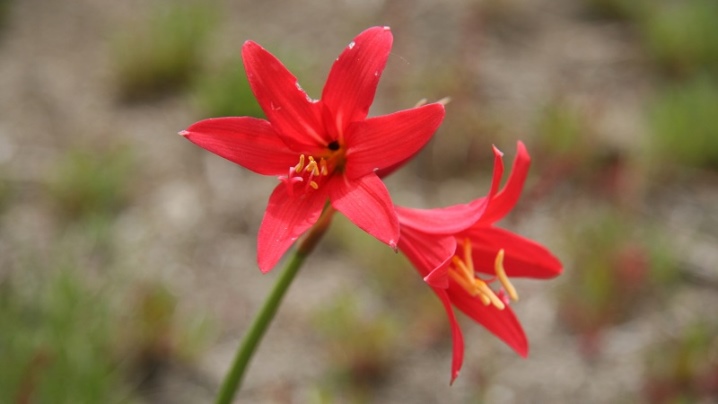
Begonia
It is a tuberous plant, the flowers of which can be colored in white, red, pink, yellow or orange tones. There are also spectacular multi-colored specimens. This beauty blooms in the middle of the summer season and until early winter. At rest, begonia stays in the period from November to March.
Begonia is a perennial. She is beautifully flowering. In height, it can grow up to 30 cm. Feels great in partial shade or in diffused light. Although in the shade, this tuberous flower feels quite well. From April to December, the plant is allowed to be in direct sunlight until 10.00 and after 17.00.
Begonia is a houseplant that needs light drying. This flower is usually watered in the morning.
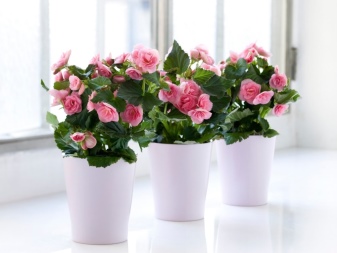
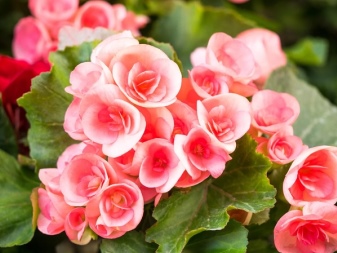
Clivia
An ornamental bulbous plant that grows in southern Africa. This is a beautiful perennial, which can reach a height of 60 cm. If you provide this pet with competent care, it can live well for several decades. In this case, the flowering of clivia will occur annually.
The plant has beautiful glossy leaves with a characteristic leathery structure. Clivia flowers look truly luxurious. They are distinguished by a rich orange-red color. The tips of the petals have a pointed structure.

Drimiopsis
It is a bulbous perennial from the asparagus family. In areas where cold temperatures are common, this native of the tropics is grown as a houseplant. The flower has a bulbous root system. The bulk of all Drimiopsis bulbs are located above the ground. Large root-type leaves are formed directly from the soil. The average length of the petiole is 5-8 cm. The leaf plates are wide and long - 11-25 cm. The shape of the leaves of this green pet is ovoid or heart-shaped. The edges of the plates are smoothed, and the tip is pointed. The foliage surface is glossy.
Usually the plates grow either monochromatic or spotted.


Nerina
Another bulbous plant with an unusual appearance. The flower bulbs are elongated, usually up to 5 cm in length. The leaf blades of the plant are long and 30 cm long. False stems can be found at their base. The foliage is linear, belt-like, shiny.
The main distinguishing feature of this flower is that he has not 1, but 2 periods of rest... One falls in the winter, and the second in the summer. Green foliage dries up only closer to spring, and throughout the winter season, new buds are laid.


Ginger
Indoor plant of the tuberous type. Forms pretty flowers in the form of miniature cones, gathering in long inflorescences. This is an absolutely unpretentious green pet that blooms every year. The ginger tubers themselves are edible. Many people grow such a plant at home because it has medicinal properties.
Ginger grows well in warm and well-lit areas. He needs regular watering... With the onset of the autumn season, the plant goes into a dormant state, signaling this with yellowed foliage.

Pleione
A tuberous plant from the orchid family. It can form from 5 to 7 peduncles of calm and delicate shades. They can be white, yellowish, pink, or lilac. The flowering period of various representatives of the species begins in the spring and summer seasons.
The spring green tubers of the playone indicate that the flowering stage has begun. These elements turn red with the onset of summer. Rest of this green pet falls in the period from autumn to spring. Playone tubers live no more than 2 years.

Gemantus
Another of the representatives of the bulbous type. Comes from the amaryllis family. The name of this plant is translated as "blood flower". Hemantus has fleshy and long leaves that are difficult to confuse with another similar plant. This is the visiting card of Hemanthus, by which many people recognize it. The most attractive are those subspecies of hemantus, which have white or blood-red flowers. The latter are distinguished by a spherical structure and appear earlier than leaf plates.
For this, the plant must be in a dry, suitable soil at a temperature of 10 degrees Celsius.


Amaryllis home
If you want to grow a bright plant in pots at home that attracts a lot of attention, then the handsome amaryllis is ideal for this. The homeland of this flower is South Africa. Only amaryllis belladonna is grown as an indoor flower.
The flower grows with long and narrow leaf plates that are dark green in color. The bulbs are oblong. Their diameter is usually 4-5 cm. The flowers have a funnel-shaped structure and are attached to long peduncles. The inflorescences are white or pink in color, gather in a small umbrella.


Vallota
It is a beautifully flowering perennial from South Africa. The bulbs of this plant quickly and easily adapt to life in indoor pots. When the flowering period ends, the vallot does not discard the foliage.
On the surface of the vallotta bulbs there is a dry layer of brown scales. The stems are dark green in color. Usually flower stalks reach 40 cm in size. At their top there are from 6 to 8 flowers, gathering in inflorescences like an umbrella. This beautiful bulbous plant blooms in July or August.

Amazon lily
A plant belonging to the amaryllis family. The homeland of the Amazon lily is Central and South Africa. The flower is distinguished by slightly wrinkled leaf blades with protruding veins. The length of the peduncles rarely exceeds 60 cm. The leaf plates grow up to 40 cm, and their width is 20 cm. The color of the leaves is dark green. On one bush of the Amazonian lily, from 2 to 7 wide leaf plates with a characteristic lanceolate shape can form. Flowering begins in August or September.
This beautiful bulbous plant loves to grow in spaciousness, so it is important to provide the Amazonian line with plenty of free space.

Eucharis
A spectacular bulbous plant that can beautify any interior. Otherwise, it is called a room daffodil. Eucharis blooms beautifully, which makes many gardeners, both beginners and experienced, fall in love. The flower almost never completely loses its foliage. An exception can only be the unwanted stress transferred by the pet or the poor conditions in which it is located.
The flower is very fond of diffused light or partial shade, but direct sunlight can be destructive for it... Eucharis is thermophilic. Such a houseplant is able to create a festive mood thanks to its beautiful and elegant appearance.


Landing rules
Planting and replanting bulbous and tuberous plants must be very careful. The health of the plant will depend on the quality of this procedure, so you need to be as careful and attentive as possible.
Bulbous pets should only be planted after a detailed examination of the bulbs themselves.They must be strong and healthy enough.
After making sure of this, you can start planting.
- Prepare a 1% potassium permanganate solution for disinfection. Leave the bulbs in this composition for a short time (30 minutes is enough).
- Consider the size of the pot... It should not be much larger than the bulb itself. If the reservoir is too spacious, the plant will begin to develop babies, and it will not reach flowering.
- Make drainage holes... Add a layer of small pebbles (gravel, expanded clay or pebbles will do).
- Lay a layer of charcoal and sphagnum, pour a layer of soil. Place an onion in a container, sprinkle it with soil. No deepening is required.
- Water the ground in a pot and move it to a cool place.


We will consider the rules for transplanting tuberous plants using the example of begonia.
- You will need a small pot. A height of 10 cm is enough.
- Drainage is poured at the bottom, for example, from expanded clay. A layer of 1.5-2 cm is enough.
- Begonia does not tolerate lime, so it is better to purchase a ready-made, slightly acidic soil mixture.
- When planting, the tuber will need to be deepened, but only by 2/3.
- You can spray the planted tuber with a spray bottle with zircon solution.


How to care?
Indoor plants of any type need proper care. If not provided, neither bulbous nor tuberous flowers will grow beautiful and healthy. Let's take a look at the points of how to care for the specified landings.
Favorable conditions
Different types of plants are suitable for different types of soil. So, tuberous plantings do not tolerate acidic soil. A slightly alkaline mixture is ideal for them. The soil in which tuberous flowers grow should not be waterlogged. Bulbous plants also do not tolerate waterlogged soil. However, these plants are undemanding to the soil.
For them, the compositions used for flowering plantings are suitable.


Tuberous plants grow well in partial shade, but they do not get any worse from abundant lighting. Do not allow direct sunlight to fall on the flowers.... The same applies to bulbous flowers. If you neglect this rule, you can after a while see that the green pets are covered with burns, and this is not good.
Different types of bulbous flowers do well in different conditions, but most of them are light-loving. As for a comfortable temperature, in warm seasons, pots of bulbous flowers should be kept in a bright room with a temperature of 20 to 25 degrees. In the winter season, these plants must be transferred to a cool room, where the temperature is kept from 10 to 13 degrees. Tuberous flowers require approximately the same temperature conditions. In summer, they feel good in rooms with temperatures from 20 to 24 degrees, and in winter - from 16 to 18 degrees, but not lower than 15.
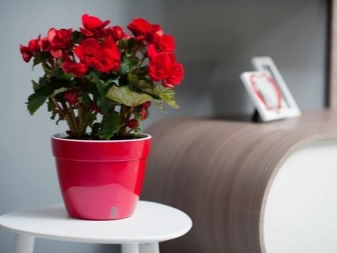

Watering
Different varieties of bulbous and tuberous indoor plants require different watering regimes. That is why, when choosing a certain flower for home growing, it is so important to know all its features and requirements for care measures. Most varieties of bulbous and tuberous plantings have in common that they do not tolerate conditions in which the soil is always excessively moist. Flowers should be watered regularly and in suitable volumes, but you shouldn't overdo it with the added liquid. - this can lead to rotting of the roots and serious diseases of pets. Neither should you neglect watering, forgetting about them for a long time, especially if the flower is moisture-loving.
For irrigation it is necessary to use only settled or rainwater at room temperature. You can't just take liquid from the tap and pour it into a flower pot, no matter what species it belongs to.


Top dressing
In caring for indoor flowers of both bulbous and tuberous types, proper feeding is important.
So, for the first, the following components are suitable.
- Potassium... The specified trace element is vital for absolutely all varieties of this plant family.It has a beneficial effect on bud setting and flowering period.
- Phosphorus... The formation of peduncles and the activity of their further growth directly depend on the amount of this element in the soil.
- Nitrogen... If there is too little of this component in the soil, the growth rate of the flower can be inhibited, and fewer leaf plates are formed.

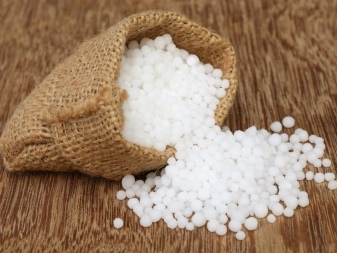
For the first time, it is necessary to feed the bulbous flowers immediately after the formation of the first arrows, and then in the fall, when the foliage stops growing. The last time fertilization will need to be applied before the onset of the dormant period of the flower.
Many plants belonging to the tuberous category are suitable for high-quality mineral fertilizers. In garden stores, you can find special complex fertilizing, with which the flower will grow healthy and beautiful. The fertilization regime depends on the requirements of a particular type. For example, feeding begonias are needed once a month. They begin to make them from the moment when the plant reaches 9-10 cm.


Helpful hints and tips
If you are determined to start growing tuberous or bulbous flowers at home, then you should take on board some useful tips and recommendations for their care and maintenance.
- To plant bulbous indoor flowers, only good clay pots with thin walls are suitable.
- With the onset of a dormant period of plants, it will be necessary to either reduce watering, or stop them altogether.... When the planting is in the active stage of growth, on the contrary, it must be watered regularly. A high level of humidity has to be addressed when it comes to forcing flowers in a greenhouse.
- Watering indoor plants of the types considered, it is recommended to use the bottom irrigation method... Thus, it will be possible to avoid unnecessary waterlogging of the soil and rotting of the bulbs.
- And in the case of bulbous and tuberous flowers we must not forget about the drainage layer in the potwhere they will be planted.
- Some indoor plants, such as the bulbous perennial weltheimia, are susceptible to fungal diseases. These are serious ailments that can affect the flower and its "neighbors". Plantings with similar problems need extremely moderate watering.... Waterlogging can be dangerous.
- Always keep an eye on the health of your green pets. If you notice that the potted plants do not look good and are clearly ill, there is no time to waste.... It is necessary to determine as soon as possible what is the cause of the problems that have arisen, and then proceed to solving them.


It can be very difficult for a beginner florist to understand what contributed to the development of a particular disease, therefore, in case of doubts and questions, it is better to consult with a more experienced person who is well versed in such matters.
In the next video, you will find recommendations for caring for an Amazon lily at home.































The comment was sent successfully.